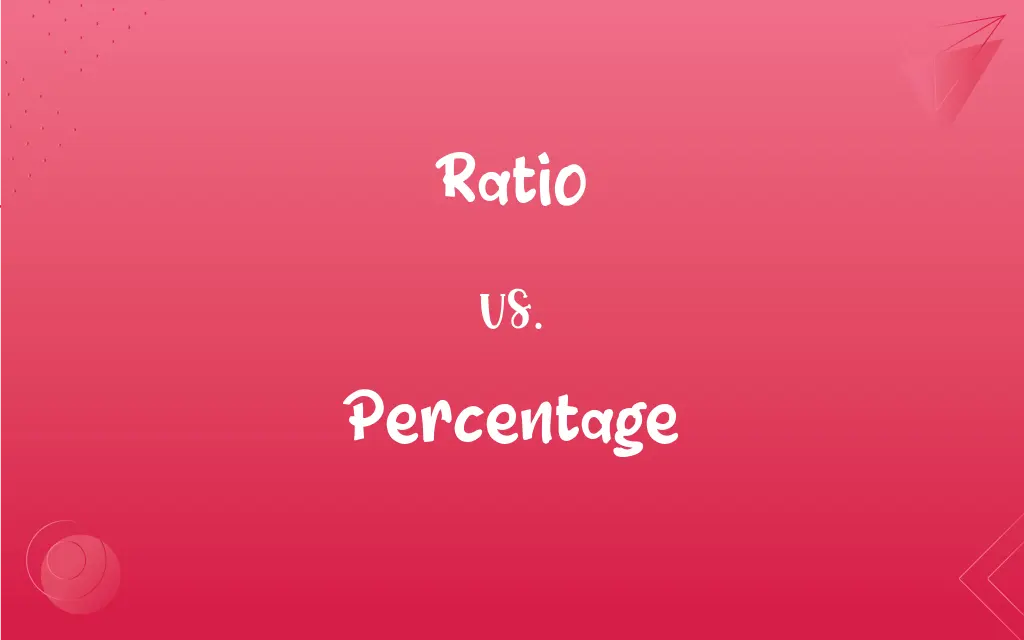Ratio vs. Percentage: What's the Difference?
Edited by Aimie Carlson || By Harlon Moss || Updated on November 8, 2023
A ratio compares two quantities, while a percentage represents a part per hundred of a whole.

Key Differences
A ratio is a relationship between two numbers showing how many times the first number contains the second. It is expressed using the colon symbol (:) or as a fraction. Ratios are used to compare different types of quantities without requiring them to have the same units. For example, if there are 2 apples for every 3 oranges, we have an apple-to-orange ratio of 2:3.
A percentage is a way of expressing a number as a fraction of 100, denoted using the percent symbol (%). It is used to describe how large one quantity is in relation to another where the second quantity is always 100. For instance, if 50 out of 100 apples are red, then 50% of the apples are red.
Ratios provide a direct comparison between two quantities, which can be scaled up or down proportionally. Percentages, however, relate specifically to a proportional part of a whole based on a scale of 100, which makes it a dimensionless number. This means that percentages are often used to compare parts of a whole without concern for the size of the whole.
Ratios can be converted into percentages by finding the equivalent fraction that has 100 as the denominator. Conversely, a percentage can be expressed as a ratio by converting the percentage to a fraction of the form x/100, and then simplifying it if possible.
Both ratios and percentages are essential tools in mathematics and are used for different purposes. Ratios are useful for showing the relative sizes of two quantities, while percentages are excellent for showing parts of a whole in an easily understood format because they are always on the same scale: out of 100.
ADVERTISEMENT
Comparison Chart
Expression
As a fraction or with a ":"
As a part of 100 with a "%"
Scale
Any scale
Fixed scale of 100
Usage
Comparing two quantities
Expressing a fraction of a whole
Units
Can compare different units
Dimensionless, no units
Conversion
Can be scaled proportionally
Fixed, represents an absolute part of a whole
ADVERTISEMENT
Ratio and Percentage Definitions
Ratio
Comparative measure.
The ratio of teachers to students is 1:30.
Percentage
Fraction of a hundred.
He scored 90% on the test.
Ratio
Proportional relationship.
Mix the drink in a 1:2 ratio of syrup to water.
Percentage
Proportion to total.
About 25% of the budget is used for marketing.
Ratio
Quantitative relation.
She studied the gender ratio in the company.
Percentage
Quantitative part.
A large percentage of the area is forested.
Ratio
Scale representation.
The map's ratio is 1 centimeter to 100 kilometers.
Percentage
Degree of amount.
She received a 10% discount on the purchase.
Ratio
Fractional expression.
The ratio of width to height is 16:9.
Percentage
Statistical measure.
The percentage of error in the experiment was minimal.
Ratio
Relation in degree or number between two similar things.
Percentage
A fraction or ratio with 100 understood as the denominator; for example, 0.98 equals a percentage of 98.
Ratio
(Mathematics) A relationship between two quantities, normally expressed as the quotient of one divided by the other; for example, the ratio of 7 to 4 can be written 7:4 or 7/4. A ratio can often also be expressed as a decimal or percentage.
Percentage
The result obtained by multiplying a quantity by a percent.
Percentage
A proportion or share in relation to a whole; a part
The hecklers constituted only a small percentage of the audience.
Percentage
An amount, such as an allowance, duty, or commission, that varies in proportion to a larger sum, such as total sales
Work for a percentage.
FAQs
What does a ratio tell you?
The relative size or frequency of one quantity compared to another.
Is percentage always less than 100?
No, it can be more than 100 if the part exceeds the whole.
Are percentages always a comparison to 100?
Yes, by definition percentages are parts per hundred.
Is a ratio a fraction?
Yes, it can be expressed as a fraction.
How do you convert ratios to percentages?
Divide the first number by the second and multiply by 100.
Can ratios be percentages?
Yes, when converted to a comparison with 100.
Do percentages require a denominator of 100?
Yes, they represent a part of a fixed denominator of 100.
When is a ratio used in business?
In financial ratios, productivity measures, etc.
Can a percentage be a ratio?
Yes, it can be seen as the ratio of a part to a whole of 100.
Are ratios always whole numbers?
No, they can be any real numbers.
Are ratios used in recipes?
Yes, to maintain the proportion of ingredients.
Can you simplify ratios?
Yes, by dividing both sides by their greatest common divisor.
Can percentages be decimal?
Yes, percentages can be expressed as decimals.
Do ratios have units?
They can, if comparing quantities with units.
Are percentages intuitive?
Yes, because they are a common way to represent data.
Can you add ratios directly?
Only if they have the same denominator.
Can percentages be negative?
Yes, to represent a loss or decrease.
Is percentage useful in data analysis?
Yes, for comparing data points to a whole.
How are percentages used in finance?
To represent interest rates, growth, discounts, etc.
Is 100% equal to a whole?
Yes, it represents the entire quantity.
About Author
Written by
Harlon MossHarlon is a seasoned quality moderator and accomplished content writer for Difference Wiki. An alumnus of the prestigious University of California, he earned his degree in Computer Science. Leveraging his academic background, Harlon brings a meticulous and informed perspective to his work, ensuring content accuracy and excellence.
Edited by
Aimie CarlsonAimie Carlson, holding a master's degree in English literature, is a fervent English language enthusiast. She lends her writing talents to Difference Wiki, a prominent website that specializes in comparisons, offering readers insightful analyses that both captivate and inform.































































